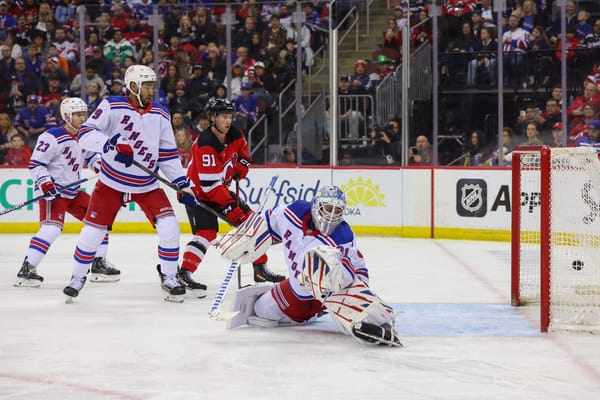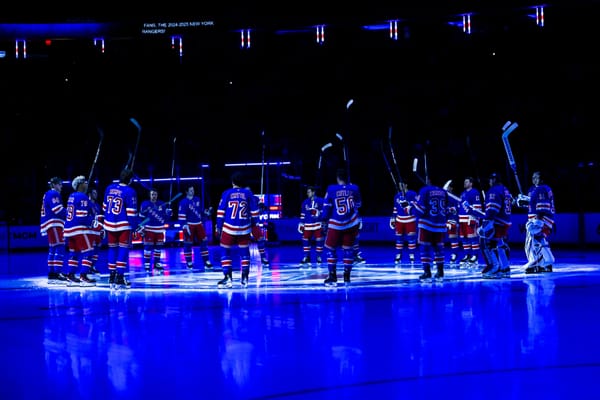The New York Rangers Should Offer Sheet Elias Pettersson
The Rangers need to upgrade their center position and should target an elite option this offseason...no, not THAT elite option.
The New York Rangers are poised, one way or another, for a big offseason. After a season that ended with owner James Dolan removing both President of Hockey Operations John Davidson and General Manager Jeff Gorton and installing Chris Drury in their place, the message from the top appears to be that the rebuild is over and it is time to start winning, and winning now. Out is head coach David Quinn and a majority of his assistants and Gerard Gallant is in, but there are still other areas that the team needs to address in order to take that next step into becoming a legitimate contender.
If there was one true area of weakness for the Rangers last season, it was arguably down the middle. Mika Zibanejad dealt with the lingering effects of COVID-19 during the first half of the season. Ryan Strome played decent enough second line hockey alongside Artemiy Panarin once again, and while Filip Chytil got off to a hot start, his season was derailed by a hand injury suffered just four games into the season. That’s the basics of the situation at center, and to be honest, the less said about Brett Howden, the better. The moral of the story is that if the Rangers want to really compete with the likes of Tampa, Boston, Carolina, and the Islanders they’re going to have to beef up their center position and there is a major opportunity to add young, elite talent down the middle to play alongside the strong stable of wingers the Blueshirts have built over the last couple of seasons.
With the Rangers looking to improve the roster this offseason and address that talent gap, everyone has their sights set on Jack Eichel and his ever dissolving relationship with the Buffalo Sabres. Without a doubt, the Rangers bringing in Eichel fulfills the goal of adding young, elite center talent but what if there was another, arguably more cost-effective, option for the Rangers to go after come July 1st? Instead of looking towards Western New York, extend your gaze further west, in the general direction of Vancouver and Elias Pettersson.
Elias Pettersson is a 22-year-old left-handed shooting center for the Vancouver Canucks with 65 goals and 153 points in his first 165 career games in the NHL. Pettersson is entering his first season as a Restricted Free Agent as his Entry Level Contract expires this offseason, leaving Pettersson open to an offer sheet opportunity. In other words, Elias Pettersson is the perfect center target for the Rangers come July 1st. Now, before we dive into why Pettersson should be a target for the Rangers this offseason, let’s review what, exactly, an offer sheet is in theory and what it actually is.
First off, an offer sheet is a contract presented to a restricted free agent whose rights are still held by another team (via CapFriendly). It is a method for teams to acquire younger talent that is clearly defined the CBA that comes with draft pick compensation for the team losing the player that signed the offer sheet. The team holding the rights to the RFA signing the offer sheet have seven days to match the offer sheet, or they are granted a package of draft picks as compensation based on the AAV of the contract signed by the player. If the offer sheet goes through and the team retaining the rights do not match the offer sheet, then the player and his new team agree to the contract as defined by that offer sheet. In theory, the offer sheet is a pretty simple and quite powerful tool in the CBA that is rarely utilized.
In reality, the very idea of an offer sheet is seemingly a boogey man, something akin to the monster under the bed, a tool that every general manager in the league can utilize but refuse to do so in fear of reprisal or maybe because one of the most famous uses of an offer sheet resulted in one general manager of a professional hockey team threatened to fight another general manager of a professional hockey team in a barn. No, seriously, that actually happened.
Offer sheets have been part of the NHL’s CBA since 1986 and there have been 36 offer sheets signed since the inception of the rule, with 13 offer sheets being accepted and compensation going the other way. Since the 2005-06 lockout and the implementation of the hard salary cap, there have been only nine offer sheets extended, with one being accepted when Dustin Penner decided to foment chaos by accepting the offer sheet sent to him by the Kevin Lowe and the Edmonton Oilers. The most recent offer sheet was in 2019 when the Montreal Canadiens sent Carolina Hurricanes winger Sebastian Aho a 5 year, $42 million contract which the Canes matched shortly thereafter.
Now, why don’t teams utilize the offer sheet more frequently? Well, it is most likely because of the tightly-knit Old Boys’ Club that is the NHL’s executive level have a “gentleman’s agreement” to not use something that was legally defined in the CBA and is a perfectly viable method of roster building, while also allowing players a bit more freedom in choosing where they can play earlier in their careers. On top of that, there could be a fear of retaliation from other GMs, essentially if one team offer sheets another then that team’s restricted free agents might be up for grabs, which is exactly how it should work...? Anyway, one other aspect of the hesitancy to utilize the offer sheet is the draft pick compensation that is determined by the AAV or annual average value of the contract being offered.
Draft Pick Compensation
| Annual Average Value | Draft Pick Compensation |
|---|---|
| $1-$1,439,820 | No Compensation |
| $1,439,821-$2,181,545 | 1 Third Round pick |
| $2,181,546-$4,363,095 | 1 Second Round pick |
| $4,363,096-$6,544,640 | 1 First Round pick and 1 Third Round pick |
| $6,544,641-$8,726,188 | 1 First Round pick, 1 Second Round pick, 1 Third Round pick |
| $8,726,189-$10,907,735 | 2 First Round picks, 1 Second Round pick, 1 Third Round pick |
| $10,907,736 and up | 4 First Round picks |
(Data via CapFriendly)
One thing to keep in mind is that all draft pick compensation must be the team’s original draft picks (i.e. if a team has their own 2021 1st round pick but not their 2022 1st round pick they cannot offer a player a $10 million-plus contract). Now, four first round picks and at least $10 million a year for a player is a rather steep cost for an offer sheet and that could turn a lot of teams away, it is a rather risky bet to make on a player with very little NHL experience. However, if you are paying out an $8-$10 million per year contract, wouldn’t you rather pay that money to a player in their early twenties with their best years ahead of them and not their late twenties when their best are behind them?
Now, what does all of this have to do with Elias Pettersson? Well, as I mentioned above, he is an RFA this offseason and in his short stint in the NHL has put up rather impressive numbers for the Canucks, with a career 49.7 GAR and 7.8 WAR in those 165 games played (via Evolving-Hockey) and 51.3 CF% and 50.49 xGF% over those three years.
The Swedish pivot has all the tools to be a truly elite talent, driving play in the offensive zone while also doing a fine job of shutting down opposing offenses in his own zone, while also being an above-average natural shooter. Essentially everything the Rangers could possibly want in a player. Though there are some concerns with Pettersson, he has yet to play a full season in the league, suffering a concussion in his rookie season that saw him miss eleven games and he missed time this year with a wrist injury, though he still put up 21 points in 26 games.
The question you might ask is “why not just trade for Eichel, we already know he is an elite center?” It is a very valid question and this is not to say that Eichel is not a great player, I think the offer sheet for Pettersson is much more cost effective option than trading for the disgruntled Buffalo center. The wonderful folks over at Evolving-Hockey project Elias Pettersson to make $5.95 million per year on his next contract, let’s round up and say it’s an even $6 million/year. Another aspect of this is that offer sheets are determined by total salary divided by five years, if the contract is longer than a 5 year term so an offer sheet is $6 million per year over seven years, then the AAV is going to come in around the $10 million mark or higher, which would mean the Rangers are looking at 4 first round picks in compensation.
The calculation is the full contract value divided by the lesser of either the contract term or 5 years (via @CapFriendly). So, if you offer Pettersson a 7 year, $6.25 million contract, the Offer Sheet is $43.75 million/5 years which comes out to an $8.75 mil AAV offer sheet
— Kevin (@Kpower90) June 18, 2021
When you figure out the actual math around offer sheets you realize that it is even STUPIDER that GMs don't utilize them to their fullest. You're not even paying out the $10+ million, just picks and the agreed AAV which is probably 2-3 mil less than the offer sheet
— Kevin (@Kpower90) June 18, 2021
The bet that Chris Drury and company would make in this instance is that those four pick will be in the 29-32 range, lower end first round picks whose value is nowhere near as high as a top 5 or top 10 pick. In the simplest terms, the Rangers would be sending four magic beans over to Vancouver for the right to have Elias Pettersson hit his prime right at the same time as Alexis Lafrenière, Kaapo Kakko, Filip Chytil, Adam Fox, Nils Lundkvist, et al. Whereas with Jack Eichel, the Rangers might have to move some of their prized prospects and younger players to bring in the former Boston University star.
I guess now we get to the disclaimer portion of this story. While offer sheeting Pettersson makes way too much sense, the reality is that the Rangers will most likely not put an offer together, for a variety of reasons. Not only would Vancouver do everything they can to keep their budding star in British Columbia, but there is the risk that if Drury were to send out the offer sheet and its accepted and the Canucks can’t match, the rookie GM runs the very very stupid risk of alienating himself among the Old Boys Club which could hurt his ability to do business with 31 other teams in the future.
But if the Rangers were ever to extend an offer sheet, it would make sense to do so for the player they desperately wanted to draft in 2017. Drury is running the show, but a hallmark of Glen Sather during his time with the Rangers was finding a way to get his “guy”. Often times this has been when a player was at the end of their career, but this would be an opportunity to get one who “got away,” but still has loads to give.




